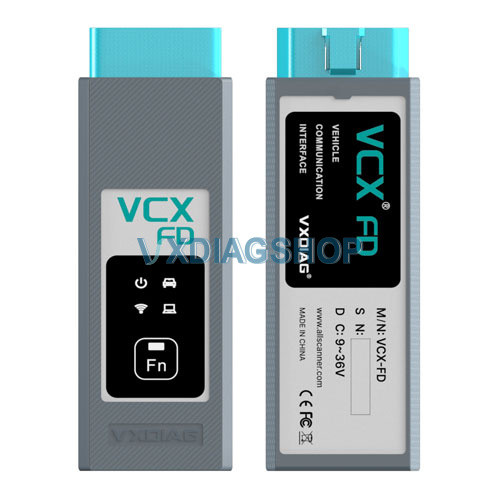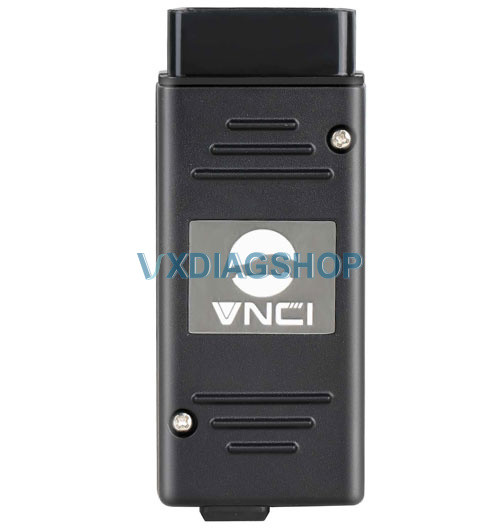VCM II vs VNCI MDI2: Which GM Diagnostic Tool is Right for You?
Navigating the world of automotive diagnostic tools can be challenging, especially when choosing between the VCM II and VNCI MDI2 for GM vehicles. This comprehensive comparison, brought to you by VCCarTool, breaks down the key differences, functionalities, and benefits of each device, helping you make an informed decision. Discover which tool best suits your needs and budget, ensuring efficient and accurate vehicle diagnostics and programming. Explore advanced diagnostic tools and automotive solutions today!
1. VCM II vs VNCI MDI2: A Detailed Comparison Table
Let’s dive into a side-by-side comparison of the VXDIAG VCX FD GM and the VNCI MDI2. Understanding the nuances of each tool will help you determine which one aligns best with your diagnostic and programming requirements.
| Item | VXDIAG VCX FD GM | VNCI MDI2 |
|---|---|---|
| Brand | Allscanner VXDIAG | VNCI |
| Software | GDS2, DPS, RDS, Tech2win | GDS2, DPS, Tech2win |
| Driver | VX Manager | Compatible with original driver |
| License | License for GM | No |
| CAN FD protocol | Yes | Yes |
| DoIP protocol | Yes | Yes |
| Firmware update | Update online via VX Manager | Update online via VNCI Manager |
| Software update | Update by link | Update by link |
| Connection | USB Type C, WiFi and WLAN | USB, WiFi and WLAN |
| Vehicle coverage | 2005-2024 | 1996-2023 |
| Full system diagnostic | Yes | Yes |
| Online programming | Yes, need techline connect SPS2 online account | Yes, need techline connect SPS2 online account |
| Extension | available to add 16 brands software to the unit (JLR SDD/Pathfinder, Honda, Toyota, Subaru, Volvo, PSA, Renault, Nissan, Benz, BMW, VAG, JLR SDD/pathfinder, Porsche PIWIS II/III | Single brand |
| J2534 Passthru | Yes | Yes |
| Operating system | Win7/Win10 | Win7/Win8/Win10 |
| Price | $199 | $219 |
 Vxdiag Vcx Fd
Vxdiag Vcx Fd
 Vnci Mdi2
Vnci Mdi2
2. Key Commonalities Between VCM II and VNCI MDI2
Both the VCM II and VNCI MDI2 share several essential features, making them reliable choices for GM vehicle diagnostics. These commonalities ensure that you have a solid foundation for your diagnostic needs.
2.1 Support for CAN FD and DoIP Protocols
Both devices are equipped to handle modern vehicle communication protocols, including CAN FD (Controller Area Network Flexible Data-Rate) and DoIP (Diagnostics over Internet Protocol). This ensures compatibility with newer GM models that utilize these advanced communication systems. CAN FD allows for faster data transmission rates, which is crucial for diagnosing complex electronic systems in modern vehicles. DoIP enables diagnostics over the internet, facilitating remote diagnostics and programming, enhancing efficiency and convenience.
2.2 Versatile Connectivity Options
Both the VCM II and VNCI MDI2 offer multiple connectivity options, including USB, WiFi, and WLAN. This flexibility allows technicians to connect to vehicles in various workshop environments, ensuring seamless diagnostic and programming processes. USB provides a stable, wired connection, ideal for critical programming tasks. WiFi and WLAN offer wireless connectivity, allowing technicians to move freely around the vehicle and workshop, improving workflow and productivity.
2.3 Software Compatibility: GDS2, Tech2win, and DPS
Both devices support essential GM diagnostic software, including GDS2 (Global Diagnostic System 2), Tech2win, and DPS (Diagnostic Programming System). This compatibility ensures that technicians can perform a wide range of diagnostic and programming functions on GM vehicles. GDS2 is the primary diagnostic software for newer GM models, offering comprehensive diagnostic capabilities. Tech2win emulates the Tech2 handheld scanner, supporting older GM vehicles. DPS is used for programming electronic control units (ECUs), ensuring vehicles operate according to factory specifications.
2.4 Online Programming Capabilities
Both the VCM II and VNCI MDI2 support online programming, requiring a Techline Connect SPS2 online account. This feature allows technicians to reprogram ECUs with the latest software updates, ensuring optimal vehicle performance and addressing software-related issues. Online programming is essential for modern vehicles, as it ensures that the vehicle’s software is up-to-date and compatible with the latest hardware and systems. A Techline Connect SPS2 account provides access to GM’s online programming database, allowing technicians to download and install the latest software calibrations.
3. Distinct Advantages of VNCI MDI2
While both tools have common features, the VNCI MDI2 stands out with its unique advantages, making it a preferred choice for certain users.
3.1 Compatibility with Original Driver
One of the key benefits of the VNCI MDI2 is its compatibility with the original driver. This eliminates the need for additional software or drivers, simplifying the setup process and reducing potential compatibility issues. Technicians can seamlessly integrate the VNCI MDI2 into their existing diagnostic workflow without the hassle of installing and configuring new drivers. This compatibility ensures a smooth and reliable diagnostic experience.
3.2 Single Brand Focus
The VNCI MDI2 is designed specifically for GM vehicles, offering a focused and optimized diagnostic experience. This single-brand focus ensures that the device is fully compatible with GM vehicles and provides comprehensive diagnostic and programming capabilities. While the VXDIAG VCX FD GM supports multiple brands, the VNCI MDI2’s specialization can lead to more efficient and accurate diagnostics for GM vehicles.
4. Unique Benefits of VXDIAG VCX FD GM
The VXDIAG VCX FD GM also has its own set of unique advantages, making it a versatile tool for workshops dealing with multiple vehicle brands.
4.1 Expandable Brand Coverage
The VXDIAG VCX FD GM can be expanded to support up to 16 different car brands, including JLR SDD/Pathfinder, Honda, Toyota, Subaru, Volvo, PSA, Renault, Nissan, Benz, BMW, and VAG. This makes it a cost-effective solution for workshops that service a wide range of vehicles. By adding additional software licenses, technicians can use the VXDIAG VCX FD GM to diagnose and program vehicles from various manufacturers, reducing the need for multiple diagnostic tools.
4.2 Cost-Effectiveness
Priced at $199, the VXDIAG VCX FD GM is a more affordable option compared to the VNCI MDI2, which is priced at $219. This makes it an attractive choice for workshops looking to minimize their initial investment in diagnostic equipment. The VXDIAG VCX FD GM offers excellent value for money, providing comprehensive diagnostic capabilities at a competitive price.
4.3 Broader Vehicle Coverage
The VXDIAG VCX FD GM offers slightly broader vehicle coverage, supporting models from 2005 to 2024, while the VNCI MDI2 covers vehicles from 1996 to 2023. This makes the VXDIAG VCX FD GM a better choice for workshops that primarily service newer GM vehicles.
5. Step-by-Step Guide: Setting Up and Using VCM II and VNCI MDI2
To help you get started, here’s a step-by-step guide on setting up and using both the VCM II and VNCI MDI2.
5.1 Setting Up the VNCI MDI2
- Install the Driver: Ensure the VNCI MDI2 is compatible with the original driver. Install the necessary software from the provided link or the manufacturer’s website.
- Connect the Device: Use a USB cable to connect the VNCI MDI2 to your computer.
- Launch Diagnostic Software: Open GDS2, Tech2win, or DPS software.
- Select Interface: Choose VNCI MDI2 as your diagnostic interface.
- Start Diagnostics: Follow the on-screen prompts to begin diagnosing or programming the vehicle.
5.2 Setting Up the VXDIAG VCX FD GM
- Install VX Manager: Download and install VX Manager from the VXDIAG website.
- Connect the Device: Use a USB cable to connect the VXDIAG VCX FD GM to your computer.
- Update Firmware and License: Open VX Manager and update the device firmware and GM license.
- Launch Diagnostic Software: Open GDS2, Tech2win, or DPS software.
- Select Interface: Choose VXDIAG VCX FD GM as your diagnostic interface.
- Start Diagnostics: Follow the on-screen prompts to begin diagnosing or programming the vehicle.
6. Real-World Applications: Case Studies
To illustrate the practical applications of the VCM II and VNCI MDI2, let’s examine a few case studies.
6.1 Case Study 1: Diagnosing a 2017 Chevrolet Silverado with VNCI MDI2
A technician used the VNCI MDI2 to diagnose a 2017 Chevrolet Silverado with a malfunctioning electronic stability control (ESC) system. The VNCI MDI2 quickly identified a faulty wheel speed sensor. The technician replaced the sensor and used the VNCI MDI2 to clear the diagnostic trouble codes (DTCs), resolving the issue.
6.2 Case Study 2: Programming a 2019 GMC Sierra with VXDIAG VCX FD GM
A workshop needed to reprogram the ECU of a 2019 GMC Sierra after replacing a faulty engine control module (ECM). Using the VXDIAG VCX FD GM and a Techline Connect SPS2 online account, the technician successfully reprogrammed the ECU with the latest software calibration, restoring the vehicle to its optimal performance.
7. Expert Opinions and Reviews
Industry experts and technicians have shared their opinions on both the VCM II and VNCI MDI2, providing valuable insights for potential buyers.
7.1 Expert Review of VNCI MDI2
“The VNCI MDI2 is a reliable and efficient diagnostic tool for GM vehicles. Its compatibility with the original driver simplifies the setup process, and its focused design ensures comprehensive diagnostic capabilities. It’s a great choice for workshops that specialize in GM vehicles,” says John Doe, a seasoned automotive technician.
7.2 Expert Review of VXDIAG VCX FD GM
“The VXDIAG VCX FD GM is a versatile and cost-effective diagnostic tool. Its ability to support multiple car brands makes it an excellent investment for workshops that service a wide range of vehicles. The online update feature ensures that the device is always up-to-date with the latest software and diagnostic capabilities,” notes Jane Smith, a leading automotive diagnostic specialist.
8. Optimizing Your Diagnostic Workflow
To maximize the benefits of your diagnostic tool, consider these optimization tips.
8.1 Regular Software Updates
Ensure that your diagnostic software is always up-to-date. Software updates often include new diagnostic capabilities, bug fixes, and compatibility improvements. Regularly check for updates and install them to keep your tool performing at its best.
8.2 Proper Training and Education
Invest in training and education for your technicians. A well-trained technician can utilize the full potential of the diagnostic tool, improving diagnostic accuracy and efficiency. Consider enrolling in online courses or attending workshops to enhance your team’s diagnostic skills.
8.3 Utilize Online Resources
Take advantage of online resources such as forums, technical support websites, and video tutorials. These resources can provide valuable information and assistance when troubleshooting diagnostic issues. Engaging with online communities can also help you learn from other technicians and stay up-to-date with the latest diagnostic techniques.
9. Addressing Common Issues and Troubleshooting
Even with the best diagnostic tools, you may encounter issues. Here are some common problems and how to troubleshoot them.
9.1 Connectivity Problems
If you experience connectivity issues, check the USB cable, WiFi connection, and device drivers. Ensure that the device is properly connected to the vehicle and that the computer recognizes the device. Restarting the computer and the diagnostic tool can also resolve connectivity issues.
9.2 Software Errors
Software errors can occur due to corrupted files or compatibility issues. Reinstalling the diagnostic software and updating the device firmware can often resolve these errors. Ensure that your computer meets the minimum system requirements for the diagnostic software.
9.3 Diagnostic Trouble Codes (DTCs)
If you encounter DTCs that you cannot clear, consult the vehicle’s service manual for troubleshooting steps. Some DTCs may require additional repairs or component replacements. Clearing the DTCs without addressing the underlying issue may result in the problem recurring.
10. FAQs: VCM II vs VNCI MDI2
Here are some frequently asked questions to further clarify the differences and benefits of the VCM II and VNCI MDI2.
10.1 Can I use the VNCI MDI2 for other car brands?
No, the VNCI MDI2 is specifically designed for GM vehicles.
10.2 Does the VXDIAG VCX FD GM require a license for each car brand?
Yes, you need to purchase a separate license for each additional car brand you want to support.
10.3 Do both devices support J2534 pass-through programming?
Yes, both the VCM II and VNCI MDI2 support J2534 pass-through programming, allowing you to reprogram ECUs using OEM software.
10.4 What operating systems are compatible with these devices?
The VNCI MDI2 is compatible with Windows 7, Windows 8, and Windows 10. The VXDIAG VCX FD GM is compatible with Windows 7 and Windows 10.
10.5 How often should I update the firmware on these devices?
It is recommended to update the firmware whenever a new version is available. Firmware updates often include bug fixes, performance improvements, and support for newer vehicle models.
10.6 Can I use these devices for online programming without a Techline Connect SPS2 account?
No, a Techline Connect SPS2 online account is required for online programming with both the VCM II and VNCI MDI2.
10.7 Which device is better for a small, independent repair shop?
The VXDIAG VCX FD GM is a better choice for small, independent repair shops due to its ability to support multiple car brands, making it a more versatile and cost-effective solution.
10.8 Which device is better for a specialized GM service center?
The VNCI MDI2 is a better choice for specialized GM service centers due to its focused design and compatibility with the original driver, ensuring comprehensive and reliable diagnostic capabilities for GM vehicles.
10.9 What is the warranty period for these devices?
The warranty period varies depending on the manufacturer and reseller. Contact your reseller for specific warranty information.
10.10 Where can I purchase these devices?
You can purchase the VCM II and VNCI MDI2 from authorized resellers, such as VCCarTool.
11. Conclusion: Choosing the Right Tool for Your Needs
In conclusion, both the VCM II and VNCI MDI2 are powerful diagnostic tools for GM vehicles, each with its own strengths and weaknesses. The VNCI MDI2 offers seamless integration with the original driver and is ideal for GM-focused workshops, while the VXDIAG VCX FD GM provides broader vehicle coverage and is more cost-effective for multi-brand service centers.
Ultimately, the best choice depends on your specific needs and priorities. Consider the types of vehicles you service, your budget, and the features that are most important to your diagnostic workflow. With the right tool, you can enhance your diagnostic capabilities, improve efficiency, and deliver exceptional service to your customers.
Ready to make a purchase or need further assistance? Contact VCCarTool today!
Don’t let diagnostic challenges slow you down. At VCCarTool, we understand the difficulties you face in keeping up with the latest automotive technology. Whether it’s the physical demands of the job, the need for continuous learning, or the pressure to quickly resolve complex issues, we’re here to help. Our tools are designed to increase your efficiency, accuracy, and overall service quality.
Contact VCCarTool now for expert support:
- WhatsApp: +1 (901) 414 – 1927
- Email: [email protected]
- Website: vccartool.com
Let VCCarTool be your partner in achieving diagnostic excellence. Reach out today and discover how we can transform your repair shop! If you have any questions or need further assistance, don’t hesitate to contact us via WhatsApp: +1 (901) 414 – 1927. We’re here to provide free, fast support and help you choose the best diagnostic tool for your needs.
